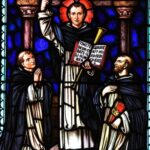St. Cyril of Alexandria
St. Cyril of Alexandria
St. Cyril of Alexandria
When they lived: St. Cyril of Alexandria, also known as Cyril the Pillar of Faith, lived during the 4th and 5th centuries AD. He was born around 376 AD and passed away on June 27, 444 AD.
Where they lived: St. Cyril of Alexandria resided in the city of Alexandria, which was a bustling metropolis and a center of learning in ancient Egypt. Alexandria was renowned for its great library and played a crucial role in the spread of Christianity during Cyril’s time.
Notable world events during the time of their life:
- The Council of Nicaea (325 AD): Cyril lived in the aftermath of this significant ecumenical council, which aimed to settle theological disputes and establish a unified Christian doctrine. The council produced the Nicene Creed, affirming the divinity of Jesus Christ, and its repercussions shaped the early Christian Church.
- The Fall of Rome (410 AD): In 410 AD, the Visigoths, led by Alaric I, successfully invaded and plundered Rome. This event shocked the Roman Empire, as the city had not been captured by an enemy in nearly 800 years. The fall of Rome had far-reaching consequences for the Western Roman Empire and marked the decline of Roman influence in the region.
- The Founding of Constantinople (330 AD): Emperor Constantine the Great established Constantinople (modern-day Istanbul) as the new capital of the Roman Empire in 330 AD. This strategic move shifted the focus of the empire to the East and laid the foundation for the Byzantine Empire, which would become a major center of Christianity and culture.
- The Life of St. Augustine (354-430 AD): St. Cyril of Alexandria and St. Augustine of Hippo were contemporaries, and while they did not personally meet, their lives and writings influenced each other. Augustine’s theological ideas, such as original sin and just war theory, left a lasting impact on the development of Christianity.
- The Huns’ Invasions (4th-5th century AD): During Cyril’s lifetime, the Huns, a nomadic group from Central Asia, unleashed a series of devastating invasions across Europe. Their onslaughts caused widespread upheaval and migrations, significantly shaping the demographic and political landscape of the time.
Their patronage: St. Cyril of Alexandria is renowned as the patron saint of theologians and scholars. His contributions to Christian theology, especially his defense of the divinity of Christ and his role in the Christological controversies, have earned him this prestigious title. Additionally, he is venerated as the patron saint of the city of Alexandria, the place where he served as the Bishop and left an indelible mark on its religious and intellectual history. As a man who dedicated his life to preserving the integrity of Christian doctrine and promoting knowledge, St. Cyril’s patronage extends to all those who seek wisdom and understanding in the pursuit of faith.
The Alexandrian Patriarch
Cyril was most probably born in Alexandria, the great city of ancient Egypt, between 370 and 380. Based on his writings, it appears that he received a solid literary and theological education. Together with his uncle, Patriarch Theophilus of Alexandria, he played a crucial role in an early dispute in the 5th century between the Egyptian and Greek churches. He was a monk before he was named a bishop.
When Patriarch Theophilus died in 412, Cyril was chosen as his successor as head of the Egyptian Church. He continued his uncle’s policy of Alexandria’s preeminence within the Church over Constantinople in spite of the political prominence of the imperial capital. Eventually, these two Eastern Churches re-established communion around the year 418.
The Nestorian Heresy
A theological issue caused a new breach between Alexandria and Constantinople ten years after Cyril became the Bishop of Alexandria. His reputation as a brilliant theologian was manifested in his defense of Catholic orthodoxy during this time.
In the year 428, a monk named Nestorius became the new Patriarch of Constantinople. Nestorius was not willing to use the term Theotokos (Mother of God) to describe the Blessed Virgin Mary. Rather, he opted to insist on the term Christotokos (Mother of Christ). This became a source of controversy, for Nestorius’ claim was against the revered doctrines of the Church.
Mary, the Theotokos
The Greek Church had already held two ecumenical councils to confirm Christ’s eternal preexistence as God before the Incarnation. Thus, based on this unchanging belief, it followed logically that Mary was the Mother of God. The doctrine of Mary as Theotokos confirmed the doctrine of the Incarnation as well as the status of Christ as equal with God the Father.
Cyril and many other bishops disagreed with Nestorius’ claims and his refusal to acknowledge Mary as the Mother of God. Nestorius’ convictions revealed a heretical view of Jesus Christ, splitting Him into two united but distinct persons: one that is fully human and born of Mary, and the other that is fully divine and not subject to birth or death.
Later Years
In 431, Cyril presided over the Ecumenical Council of Ephesus, which ran from June 22 to July 31. The council was a tumultuous affair. Cyril brilliantly defended the orthodox belief in Christ as one eternally divine person who also became incarnate as a man. Nestorius was condemned by the Council, deposed as Patriarch of Constantinople, and later suffered exile. Cyril reconciled with many other Antiochian theologians who once supported Nestorius.
Cyril of Alexandria died in the year 444. He served as Bishop of Alexandria for nearly 32 years. He was declared a Doctor of the Church in 1883. His feast day is June 27.
Five Interesting Facts About St. Cyril of Alexandria
- St. Cyril of Alexandria was long celebrated as a saint, particularly in the Eastern Catholic and Eastern Orthodox churches.
- St. Cyril of Alexandria’s reputation within the Christian world has resulted in his titles “Pillar of Faith” and “Seal of All the Fathers”.
- The Nestorian bishops at the Council of Ephesus declared St. Cyril of Alexandria a heretic, labeling him a “monster, born and educated for the destruction of the church.”
- According to some writers, St. Cyril of Alexandria’s temperament was confrontational, even divisive.
- The Roman Catholic Church did not commemorate St. Cyril of Alexandria in the Tridentine Calendar. His feast was added only in 1882, assigning it the date of February 9.
Prayer to St. Cyril of Alexandria
O God, who made the Bishop Saint Cyril of Alexandria an invincible champion of the divine motherhood of the most Blessed Virgin Mary, grant, we pray, that we, who believe she is truly the Mother of God, may be saved through the Incarnation of Christ your Son. Who lives and reigns with you in the unity of the Holy Spirit,God, for ever and ever. Amen.



